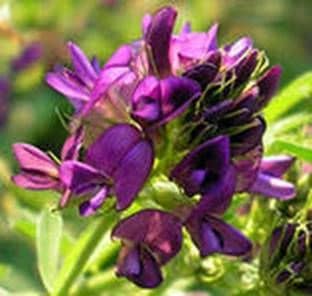
Alfalfa sowing is a perennial herbaceous plant of the legume family. The leaves are triple, the leaflets are long or linear-wedge-shaped. Stems erect or ascending, densely leafy. Flowers bluish – purple or violet, collected in the head brushes. The beans are spirally wound in 1.5-3 turns, glabrous or slightly pubescent.
Cultivate alfalfa throughout the country, but the largest areas are in the steppe and forest-steppe zones. The sowing area of the testes is 96,800 hectares.
Lucerne blooms in June – July. For beekeeping is important as a honey plant. However, the bees are also quite necessary for pollination of alfalfa. The latter is complicated by the fact that the alfalfa flower has this feature: its stamina tube is always in a stressed state. When the bee sits on a flower, it straightens with strength (it undergoes a tripling) and hits the bee along the proboscis. Therefore, the bees take most of the nectar from the side of the flower, pushing the proboscis between the sail and the boat, without polishing it while doing so. During periods of strong alfalfa nectar, honey bees willingly visit it.
Nectarum productivity of alfalfa depends on variety, agrotechnics and especially on climatic conditions. In the south of the republic, one flower produces 0.069-0.182 mg of sugar in nectar. Nectar productivity of 1 hectare of crops is 90-150 kg. Strong bee colonies, brought for pollination of alfalfa, collect 14-20 kg of marketable honey.
In more northern regions of nectar, the productivity of crops is 70-100 kg. In the dry season, as well as with a decrease in temperature to 10-12 њ C, alfalfa does not emit nectar.
Lucerne honey has an amber color with a weak tender flower smell and a pleasant sweet taste. Contains 40-45% fructose and 32-35% sucrose. It crystallizes after 6-7 months. crystallization is mostly fine-grained. To bee families, which they plan to use for pollination of alfalfa, it is advisable to leave the alfalfa honey for the winter.
One hectare of this crop yields 157-169 kg of pollen. However, bees collect it reluctantly, which is explained by the presence in it of specific, unpleasant for bees substances – repellents.
Щавелевая кислота инструкция. Пчелы пьют воду.
Медоносы